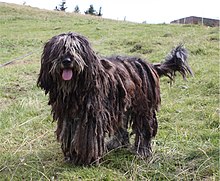Bergamasco Shepherd
The Bergamasco is a breed of dog with its origins in the Italian Alps near Bergamo, where it was originally used as a herding dog.
Appearance
The Bergamasco should be a medium size dog, well proportioned and harmonious having a rustic appearance. It is a solidly compact dog with a strong, powerful build that gives it great resistance without taking away any of its agility and speed of movement. Males weigh 32–38 kilograms (71–84 lb) and females weigh 26–32 kilograms (57–71 lb). Their height is around 54–62 centimetres (21–24 in) and the life expectancy is 13-15 years.
Coat and color
The breed's most distinctive feature is the unusual felted coat, a normal and healthy characteristic of the breed. The coat is characterized by three types of hair: a fine, dense, oily undercoat, long harsher hairs similar to a goat's and a top woolly outer-coat.[1] The three types of hair weave together as the dog gets older to form flat mats or flocks. The mats start from the spine and go down the flanks, growing every year to reach the ground. The color of the coat can be anything from an appearance of gray or silver gray (in fact a merle) to a mixture of black to coal, with brown shades also intermixed. These colors may have served as a camouflage when working in the mountains.
Bergamascos are born with short, smooth fur, which slowly develops the characteristic mats as the dog grows.
Activities
Bergamasco can compete in dog agility trials, obedience, showmanship, flyball, tracking, and herding events. Herding instincts and trainability can be measured at noncompetitive herding tests. Bergamasco exhibiting basic herding instincts can be trained to compete in herding trials.[2] The Bergamasco is still used in the Alps in Italy and in Switzerland to herd cattle. The cattlemen just let the dog go and the dog brings the herd back to the stable without human supervision. Bergamascos are often photographed herding sheep, but they are actually superb cattle dogs, who can perform in a mountain environment.
History
The first centers for domestication of sheep and goats appears to be the Zagros Mountains which straddle the Iraq-Iran border. In this region originated a type of dogs with long, bristly coats, probably descended from a wolf with a very thick coat ("Canis lupus laniger").
The dogs emigrated with shepherding population groups that moved from east to west in search of new pastures, settling in mountainous zones along a practically uninterrupted line from the upper planes of Asia over all the mountains of Anatolia, the Caucasus, the Carpathians, the Alps, the French Central Massif to the Pyrenees. Certain of these nomads ultimately settled in the Italian Alps and remained there; their dogs became what is now known as the Bergamasco.
The characteristics shared by all these dogs are: a robust constitution and thick, rough haired coats with more or less pronounced tendencies to felting on all parts of the body including the head where the hair often forms a curtain in front of the eyes.
These characteristics have become inbred due to adaptation to the climate and geographical locations of their places of origin and maintained through environmental conditions. For instance, the felting protects against harsh mountain winter climates, as well as from bites and attacks from wolves and other predators of the flock. The curtain of hair over the eyes protects them from the bright sunlight reflected on the snow.
In Italy, the dogs that became the Bergamascos worked closely with their shepherds in a one-to-one relationship, the goal of which was to protect the flock. Unlike some other shepherding breeds, which are taught to execute exact commands from their masters, the Bergamasco enjoyed a unique partnership with its shepherd in the isolated high mountain valleys: with just one human, a small number of dogs, and hundreds of sheep to tend, the shepherd needed his helpers to be as independent as possible, and so the Bergamasco was developed to problem-solve on its own. Thus, while it learned to take its lead from its shepherd, the manner in which it accomplished what the shepherd wanted was left up to it. And so, it learned to identify problems and to think its way through them, and to accomplish the goal in whichever way seemed best, given the always changing circumstances in the mountain valleys.
As a result, Bergamascos developed into a highly intelligent breed that combines a deep desire to please and help its master with an ability to think for itself and to figure out its own ways to accomplish the mutual goals. Thus, to a certain extent, it for good reason sees itself more as an equal working partner than as an inferior subordinate. This makes the Bergamasco an excellent choice for a person who appreciates intelligence and self-sufficiency in a companion.
Bergamascos began to mongrelize and were in danger of becoming extinct after World War II, when wool production fell off and there was less need for shepherding dogs. Dr. Maria Andreoli, an Italian breeder, was instrumental in saving the breed before it became extinct. As a trained scientist, she was able to study and observe the genetic traits of the breed, and through 40 years of careful breeding has developed many lines of champion dogs. It is largely due to Mrs. Andreoli and her Dell' Albera kennel that good, established reliable bloodlines were developed, and it is through her generous help and sharing of her knowledge and expertise that the Bergmasco has been able to be so successfully introduced and developed in the US.
 | ||||||||||||||||||||||
| Bergamasco in the Italian Alps at work | ||||||||||||||||||||||
| Other names | Bergamasco Shepherd Dog Bergermaschi Cane da pastore Bergamasco | |||||||||||||||||||||
|---|---|---|---|---|---|---|---|---|---|---|---|---|---|---|---|---|---|---|---|---|---|---|
| Country of origin | Italy | |||||||||||||||||||||
| ||||||||||||||||||||||
| ||||||||||||||||||||||

No comments:
Post a Comment